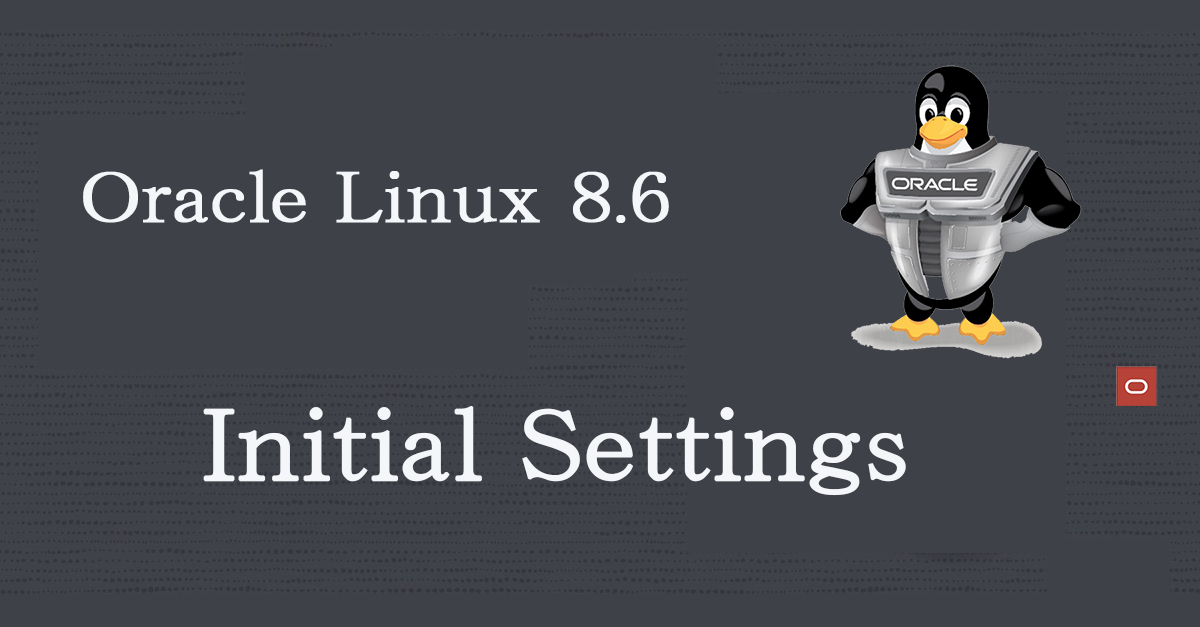Contents
1. Install bash completion extension package
|
1 2 |
# dnf -y install bash-completion # reboot |
2. Disable SELinux
First, disable selinux. selinux is a feature that improves auditing and security in Linux, but when enabled, it places considerable restrictions on the behavior of services and on what can be configured. Therefore, it is basically disabled in many cases.
|
1 2 3 4 5 |
<span style="font-size: 16px;"># getenforce ← Check SELinux functionality Enforcing ← SELinux is effective # setenforce 0 ← Disable SELinux functionality # getenforce ← Reconfirmation of SELinux functionality Permissive ← SELinux functionality is disabled.</span> |
As it is, seinux will return to be enabled once the server is restarted, so to permanently disable selinux, modify the /etc/sysconfig/selinux file.
|
1 |
<span style="font-size: 16px;"># vi /etc/sysconfig/selinux</span> |
Change "SELINUX=enforcing" to "SELINUX=disabled"
|
1 2 3 4 5 6 7 8 9 10 11 12 13 |
<span style="font-size: 16px;"># This file controls the state of SELinux on the system. # SELINUX= can take one of these three values: # enforcing - SELinux security policy is enforced. # permissive - SELinux prints warnings instead of enforcing. # disabled - No SELinux policy is loaded. #SELINUX=enforcing <span style="color: #ff0000;">SELINUX=disabled</span> # SELINUXTYPE= can take one of these three values: # targeted - Targeted processes are protected, # minimum - Modification of targeted policy. Only selected processes are pro tected. # mls - Multi Level Security protection. SELINUXTYPE=targeted</span> |
3. Modernize the system
Package updates are performed as soon as possible immediately after OS installation.
However, when a dnf update is performed, a kernel update is also performed at the same time.
A kernel update may require rebooting the system or stopping services, or worse, a kernel panic may occur and the system may not boot. It is wiser to exclude the kernel from the update.
The kernel can be excluded from updates by running dnf -y update with "--exclude=kernel*" after it.
|
1 |
<span style="font-size: 16px;"># dnf -y update --exclude=kernel*</span> |
4. Services to be stopped due to security measures
Stop the following services that you deem unnecessary.
| atd | Daemon that executes scheduled commands on a one-time basis. |
| kdump | When a system crashes, the service saves a dump file to help determine the cause. |
| lvm2-monitor | Daemon for fault monitoring when using Logical Volume Manager (LVM) |
| mdmonitor | Software RAID Monitoring Services |
| smartd | Obtain self-diagnostic function information by S.M.A.R.T. of Hard Dix |
| tuned | Use CPU governor to force CPU to run at maximum performance |
|
1 2 3 4 5 6 7 8 9 10 11 12 13 14 |
<span style="font-size: 16px;"># systemctl stop atd.service # systemctl disable atd.service # systemctl stop kdump.service # systemctl disable kdump.service # systemctl stop lvm2-monitor.service # systemctl disable lvm2-monitor.service # systemctl stop mdmonitor.service # systemctl disable mdmonitor.service # systemctl stop smartd.service # systemctl disable smartd.service # systemctl stop tuned.service # systemctl disable tuned.service # systemctl stop dm-event.socket # systemctl disable dm-event.socket</span> |
5. Adding Repositories
5.1 Add EPEL repository
|
1 2 |
<span style="font-size: 14px;"># dnf install https://dl.fedoraproject.org/pub/epel/epel-release-latest-8.noarch.rpm -y # vi /etc/yum.repos.d/epel.repo</span> |
|
1 2 3 4 5 6 7 8 9 10 11 12 13 |
<span style="font-size: 14px;">[epel] name=Extra Packages for Enterprise Linux $releasever - $basearch # It is much more secure to use the metalink, but if you wish to use a local mirror # place its address here. #baseurl=https://download.example/pub/epel/$releasever/Everything/$basearch metalink=https://mirrors.fedoraproject.org/metalink?repo=epel-$releasever&arch=$basearch&infra=$infra&content=$contentdir enabled=1 ← Repository enabled (0 : Repository disabled) priority=10 ← Specify priority in the range of 1~99 gpgcheck=1 countme=1 gpgkey=file:///etc/pki/rpm-gpg/RPM-GPG-KEY-EPEL-8 [epel-debuginfo] name=Extra Packages for Enterprise Linux $releas</span> |
5.2 Add Remi's RPM repository
|
1 |
# dnf -y install https://rpms.remirepo.net/enterprise/remi-release-8.rpm |
|
1 2 3 4 5 6 7 8 9 10 11 12 13 14 15 16 |
# vi /etc/yum.repos.d/remi-safe.repo # This repository is safe to use with RHEL/CentOS base repository # it only provides additional packages for the PHP stack # all dependencies are in base repository or in EPEL[remi-safe] name=Safe Remi's RPM repository for Enterprise Linux 8 - $basearch #baseurl=http://rpms.remirepo.net/enterprise/8/safe/$basearch/ #mirrorlist=https://rpms.remirepo.net/enterprise/8/safe/$basearch/httpsmirror mirrorlist=http://cdn.remirepo.net/enterprise/8/safe/$basearch/mirror enabled=1 ← <span style="font-size: 14px;">Repository enabled (0 : Repository disabled)</span> priority=10 ← <span style="font-size: 14px;">Specify priority in the range of 1~99</span> gpgcheck=1 repo_gpgcheck=1 gpgkey=file:///etc/pki/rpm-gpg/RPM-GPG-KEY-remi.el8[remi-safe-debuginfo] name=Remi's RPM repository for Enterprise Linux 8 - $basearch - debuginfo baseurl=http://rpms.remirepo.net/enterprise/8/debug-remi/$basearch/ |
6. Network configuration (command line configuration method)
6.1 Host Name Change
Change the host name to Lepard to try it out
|
1 2 3 |
# hostnamectl set-hostname Lepard # reboot [huong@Lepard:~]$ |
6.2 Static IP address setting
This time it is "ens160"
|
1 2 3 4 5 6 7 8 9 10 11 12 |
# ip addr 1: lo: <LOOPBACK,UP,LOWER_UP> mtu 65536 qdisc noqueue state UNKNOWN group default qlen 1000 link/loopback 00:00:00:00:00:00 brd 00:00:00:00:00:00 inet 127.0.0.1/8 scope host lo valid_lft forever preferred_lft forever inet6 ::1/128 scope host valid_lft forever preferred_lft forever 2: ens160: <BROADCAST,MULTICAST,UP,LOWER_UP> mtu 1500 qdisc fq_codel state UP group default qlen 1000 link/ether 00:0c:29:3f:48:ad brd ff:ff:ff:ff:ff:ff inet 192.168.11.83/24 brd 192.168.11.255 scope global noprefixroute ens160 valid_lft forever preferred_lft forever |
|
1 2 3 4 5 6 7 8 9 10 11 12 13 14 15 16 17 18 19 20 |
# vi /etc/sysconfig/network-scripts/ifcfg-ens160 TYPE=Ethernet PROXY_METHOD=none BROWSER_ONLY=no BOOTPROTO=none DEFROUTE=yes IPV4_FAILURE_FATAL=no IPV6INIT=no IPV6_DEFROUTE=yes IPV6_FAILURE_FATAL=no NAME=ens160 UUID=dccaab30-4028-439e-a0ec-b385375811d1 DEVICE=ens160 ONBOOT=yes IPADDR=192.168.11.11 ← Change PREFIX=24 GATEWAY=192.168.11.1 DNS1=192.168.11.1 IPV6_DISABLED=yes |
|
1 |
# systemctl restart network |
7. Network configuration (how to configure via GUI)
|
1 |
# nmtui |
7.1 Static IP address setting
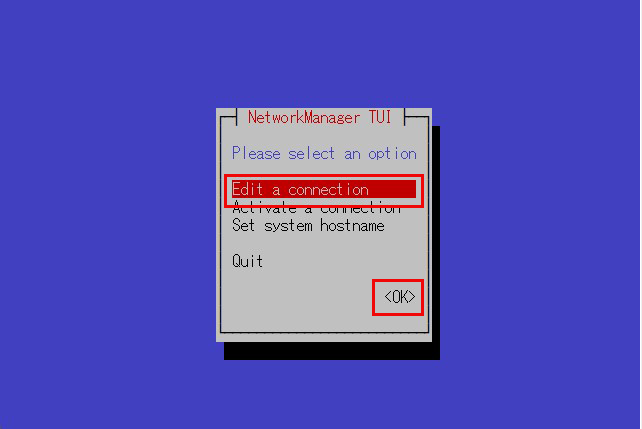
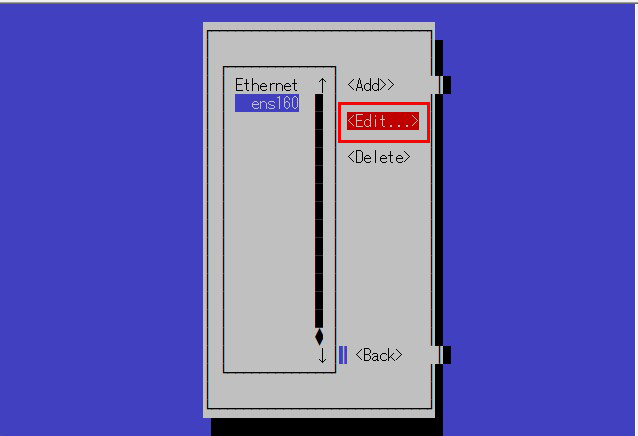
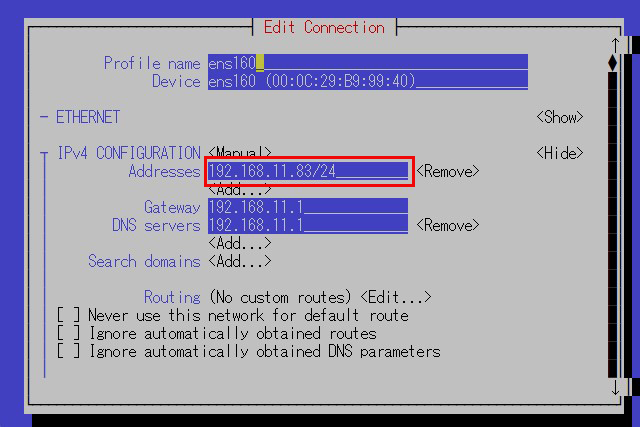
7.2 Host Name Change
Change the host name to Lepard to try it out
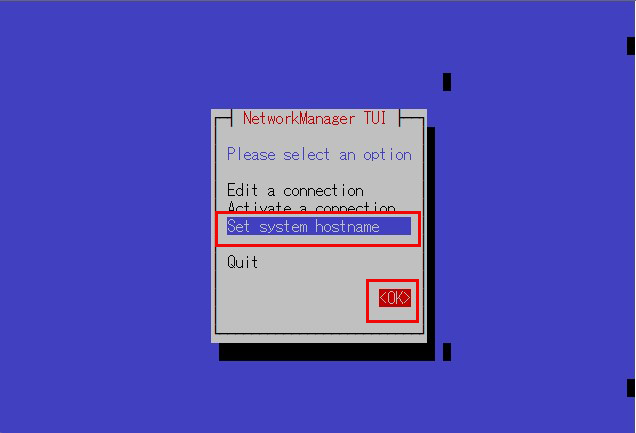
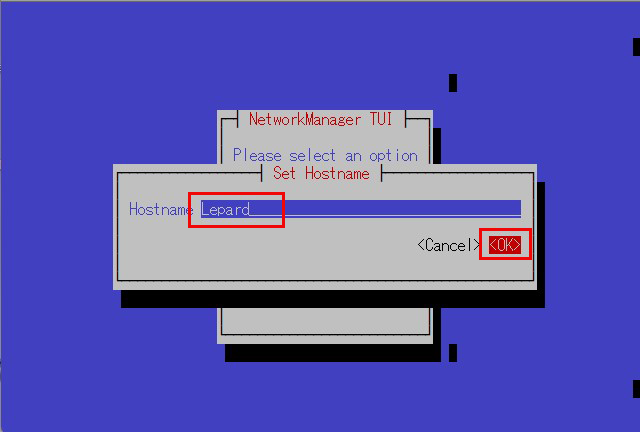
8. Vim Settings
|
1 |
# dnf -y install vim-enhanced |
|
1 2 3 4 |
# vi ~/.bashrc # Alias appended to the last line alias vi='vim' # source ~/.bashrc |
|
1 2 3 4 5 6 7 8 9 10 11 12 13 14 15 16 17 18 19 20 21 22 23 24 25 26 27 28 29 30 31 32 33 34 35 36 37 38 39 40 |
# vi ~/.vimrc " Use vim's own extensions (not compatible with vi) set nocompatible " Specify character code set encoding=utf-8 " Specify file encoding (read from the beginning until success) set fileencodings=utf-8,iso-2022-jp,sjis,euc-jp " Specify the line feed code to be recognized automatically set fileformats=unix,dos " Get Backup set backup " Specify the directory from which to obtain backups set backupdir=~/backup " Number of generations to keep search history set history=50 " Do not distinguish between upper and lower case letters when searching set ignorecase " Mixing capital letters in search terms makes the search case sensitive set smartcase " Highlight words matching your search term set hlsearch " Use incremental search set incsearch " Display line numbers set number " Visualize line breaks ( $ ) and tabs ( ^I ) set list " Highlight corresponding parentheses when entering parentheses set showmatch " No newlines at the end of files set binary noeol " Enable automatic indentation set autoindent " Color-coded display by syntax syntax on " Change color of comment text in case of syntax on highlight Comment ctermfg=LightCyan " Wrap lines by window width set wrap |

